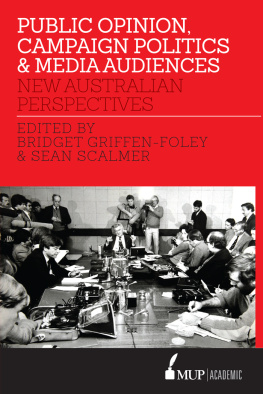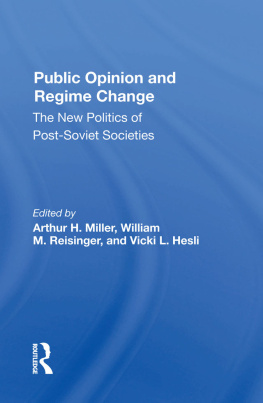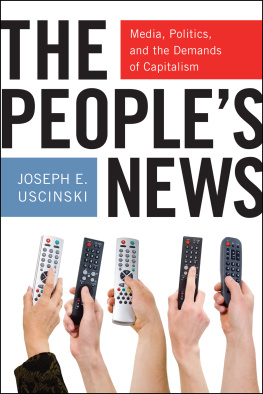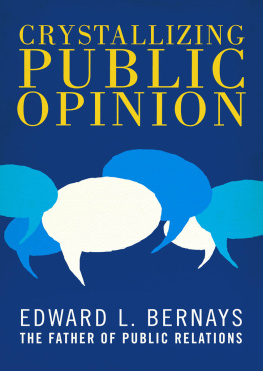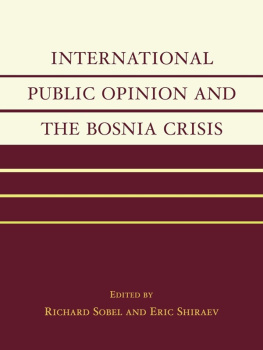Public Opinion, Campaign Politics and Media Audiences
Public Opinion, Campaign Politics and Media Audiences: New Australian Perspectives
Edited by Bridget Griffen-Foley and Sean Scalmer
MELBOURNE UNIVERSITY PUBLISHING
An imprint of Melbourne University Publishing Limited
Level 1, 715 Swanston St, Carlton, Victoria 3053, Australia
www.mup.com.au First published 2017
Text Bridget Griffen-Foley, Sean Scalmer 2017
Design and typography Melbourne University Publishing Limited, 2017
This book is copyright. Apart from any use permitted under the Copyright Act 1968 and subsequent amendments, no part may be reproduced, stored in a retrieval system or transmitted by any means or process whatsoever without the prior written permission of the publishers.
Every attempt has been made to locate the copyright holders for material quoted in this book. Any person or organisation that may have been overlooked or misattributed may contact the publisher.
Text design by Phil Campbell
Cover design by Phil Campbell
Typeset by J&M Typesetting
Printed in Australia by OPUS Group
National Library of Australia Cataloguing-in-Publication entry
Title: Public opinion, campaign politics & media audiences : new Australian perspectives / Bridget Griffen-Foley, Sean Scalmer, editors.
ISBN: 9780522869606 (hardback)
ISBN: 9780522869590 (paperback)
ISBN: 9780522869613 (ebook)
Notes: Includes bibliographical references and index.
Subjects: Press and politics.
Mass media and public opinion.
ElectionsPress coverage.
Political campaignsPress coverage
Public opinion polls.
Other Creators/Contributors:
Griffen-Foley, Bridget, editor.
Scalmer, Sean, editor.
Contents
Bridget Griffen-Foley and Sean Scalmer
David Peetz and Georgina Murray
Tim Rowse and Elizabeth Watt
Ian Watson
Judith Brett
Sean Scalmer
Bridget Griffen-Foley
Sandey Fitzgerald
Rod Tiffen, David Rowe, Sharon Coen and James Curran
Acknowledgements
The origins of this book lie in a colloquium in honour of Distinguished Professor Murray Goot hosted by the Department of Modern History, Politics and International Relations at Macquarie University on 12 December 2014. We are grateful to all the participants in that stimulating event, convened by the editors of this book, with organisational assistance provided by Nancy Guevara.
Select video from the colloquium, including Professor Deborah Brennans contribution to the panel on Living Feminism, a poem in honour of Murray delivered by Professor David Peetz, and an address in response by Murray, is available on the Centre for Media Historys YouTube channel.
We are grateful to Associate Professor Geoffrey Hawker for proposing an event to mark Murrays retirement after thirty-one years at Macquarie University, and Geoffs successor as head of the Department of Modern History, Politics and International Relations, Professor Sean Brawley, for continuing that commitment. The Faculty of Arts at Macquarie University also generously supported both the colloquium and the publication of this festschrift. Dr Craig Munro provided advice throughout the publishing process.
It is a reflection of Murrays tastes and humility that he explicitly forbade a conference dedicated to his work, but rather welcomed a discussion among scholars of the key areas of his research interest. These areaspublic opinion, political campaigning and oratory, and spectators and audiencesare reflected in the three sections of this book. We were honoured to work with the distinguished speakers at the colloquium (people who have worked with, or been inspired by Murray) and, in turn, the authors of each chapter in this book.
We are grateful to Professor John Murphy, editor of the Australian politics and policy series, and Melbourne University Publishing for seeing the potential of this book. We extend our thanks to Catherine McInnis at MUP, to our editor Meryl Potter for her thoroughness and patience, and our indexer Jon Jermey.
Bridget Griffen-Foley and Sean Scalmer
Introduction
Bridget Griffen-Foley and Sean Scalmer
Public opinion remains a preoccupation of Australian politicians, and a touchstone of political commentary. It is also a major category of scholarly analysis, and a central concept of Jrgen Habermass celebrated The Structural Transformation of the Public Sphere. Our collection brings together innovative research concerned with the history and transformation of Australian public opinion, from political science, history and media studies. It investigates three linked problems in the study of politics: the meaning, measurement and mobilisation of public opinion; the techniques of political campaigning, especially political oratory; and the nature of media audiences and spectatorship. The chapters are based on papers delivered as part of a festschrift held in December 2014 to honour Murray Goot, Distinguished Professor of Politics and International Relations, on his retirement from Macquarie University. Contributors, many of whom have collaborated or worked with Murray, are inspired by his scholarship and example. We seek to honour his work and his spirit by extending that scholarship in new and sometimes original ways.
Murrays professional life encompasses a great arc in the development of the study of politics. Born at the beginning of the postwar era, schooled first in New Zealand and then at Vaucluse Boys High, Murray entered the University of Sydney to study Arts-Law in 1964. The Department of Government and Public Administration at Sydney had been established in wartime, as a means of providing advanced training to members of an expanding civil service. Murrays arrival coincided with a period of sustained growth, as a rising generation of students sought to practise and study politics in a fresh and more radical spirit.
As a student in first-year Government, Murray joined fellow neophytes in a year-long course that included three lectures per week, extended across three terms of ten, eleven, or twelve weeks. Introduced to the study of Australian politics by Ken Turner, he joined, from 1965, the honours class taught by Professor Henry Mayer (191991). Mayers intellectual influence was particularly profound, and he would supervise Murrays sub-thesis in third year (an examination of public opinion and democratic theory) and his thesis in fourth year (an investigation of the patterns found in Australian public opinion polls, 194167).
Murray had won success as a high-school debater (challenging at the rostrum the noted future barrister Geoffrey Robertson, among others). A flair for the analysis of argument and a delight in the Socratic method (expressed also in Murrays undergraduate studies in philosophy) were harnessed and directed under Mayers mentorship. Mayers honours seminars were organised around the interrogation of key textsMurray recalls that these included Milton Friedmans Capitalism and Freedom, 1962, and Seymour Martin Lipsets Political Man: The Social Bases of Politics, 1960. Mayers published work evinced a consistently critical spirit, matched with a principled commitment to pluralism, and these would become enduring elements of Murrays own intellectual style. In 1986 Murray published a descriptive bibliography,

